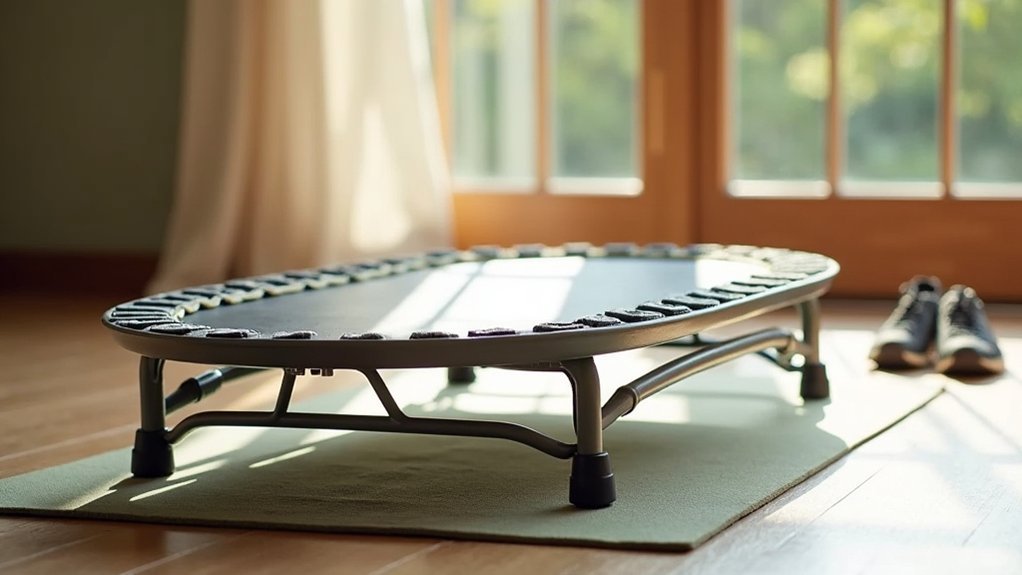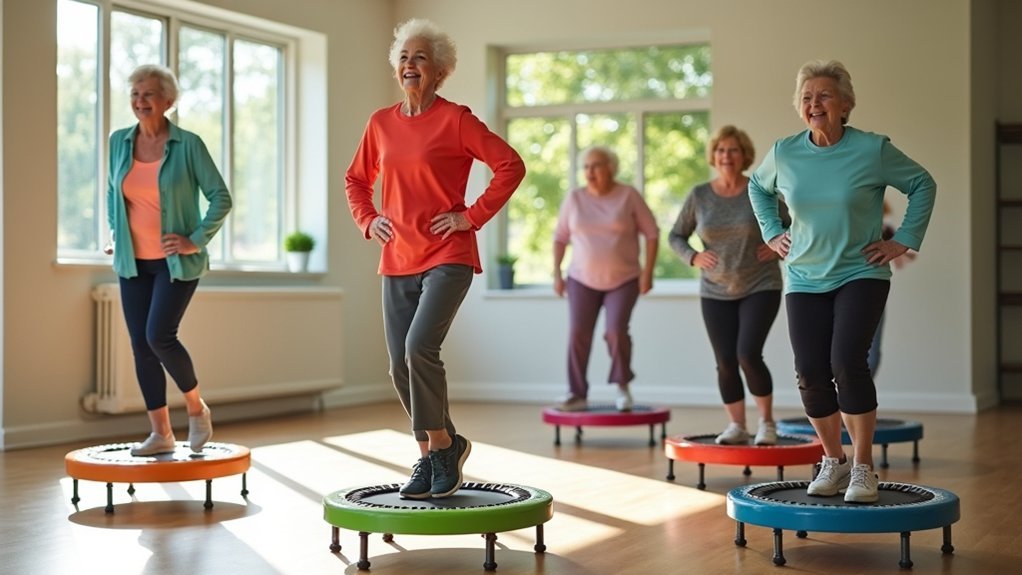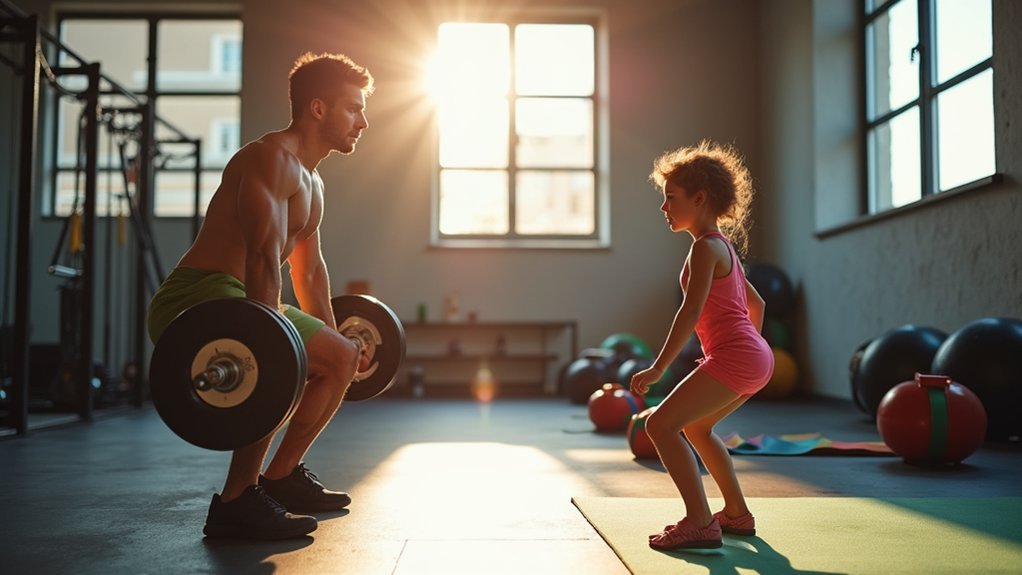For seniors with arthritis, the best rebounders include the Bellicon Classic with customizable resistance, JumpSport 350 with its No-Tip design, Acon Air 6.0 featuring joint-friendly springs, SereneLife with a built-in handlebar, and the budget-friendly BCAN 38-inch. These models offer low-impact exercise that reduces strain by 87% compared to walking, improves joint lubrication, and releases pain-relieving endorphins. The right rebounder can transform your arthritis management while enhancing balance and mobility.
Why Rebounders Are Ideal Exercise Tools for Arthritis Management

While traditional exercises often strain already painful joints, rebounding offers a low-impact alternative that still provides cardiovascular benefits. The bouncing motion reduces impact force by up to 87% compared to walking or jogging, making workouts gentler on arthritic knees, hips, and ankles.
Regular rebounding improves joint lubrication and enhances synovial fluid circulation, helping maintain cartilage health. The gentle movement strengthens bones, potentially slowing bone density loss associated with both aging and arthritis medications. Many rebounders feature bungee cords instead of springs, providing a smoother and safer experience for seniors with joint sensitivity.
Studies show rebounding can reduce pain intensity in arthritis sufferers by improving balance and stabilizing muscles around affected joints. Even short 10-minute rebounding sessions trigger endorphin release, providing natural pain relief and mood elevation – important factors for those managing chronic arthritis discomfort.
For seniors concerned about fall risks, rebounding’s stability-focused exercises develop proprioception and coordination.
Top 5 Rebounder Models Designed for Seniors With Joint Pain
Selecting the right rebounder can make all the difference for seniors managing arthritis pain.
The Bellicon Classic leads with its silent rubber bungees, customizable resistance levels, and therapeutic endorsements from physiotherapists.
Innovative rubber bungee technology meets professional approval in Bellicon’s customizable therapeutic platform for seniors.
JumpSport 350’s patented No-Tip design excels in stability with impact-reducing bungees.
The Acon Air 6.0’s hexagonal spring system minimizes joint compression and features raised edge padding to prevent tripping.
For those seeking balance support, SereneLife’s built-in foam handlebar provides security while improving walking patterns. Seniors should prioritize models with high-quality steel frames for maximum safety and longevity during therapeutic exercise sessions.
Budget-conscious seniors should consider BCAN’s 38-inch non-slip trampoline, offering a waterproof PVC mat and tool-free assembly under $100.
Each model addresses specific arthritis needs through thoughtful design elements focused on safety, stability, and joint protection.
Key Safety Features to Look for When Selecting a Senior-Friendly Rebounder

Safety should be the top priority when choosing a rebounder for seniors with arthritis. Look for models with wide, stable bases and anti-slip feet to prevent unwanted movement during exercise.
Padded, adjustable handles provide essential support and stability, especially for those with joint pain. Spring protection is essential—ensure springs are covered with quality padding to prevent injuries.
The surface should offer effective shock absorption to minimize stress on sensitive joints. A high-quality mini trampoline effectively absorbs shock, reducing strain on knees, hips, and spine that are commonly affected by arthritis. Durability matters too; invest in robust materials that will withstand regular use.
Consider rebounders with non-slip grip surfaces, safety enclosures, and clear weight capacity guidelines. Some models feature height adjustments and soft landing areas around the perimeter.
Easy assembly and portability are practical considerations that will enhance your overall experience.
Gentle Rebounding Exercises That Improve Mobility Without Stressing Joints
Rebounding exercises can transform mobility for seniors with arthritis when performed correctly. Start with the Health Bounce—a gentle, low-intensity movement that keeps your feet on the rebounder while your body experiences subtle bouncing motions. This improves circulation without stressing joints.
As you gain confidence, try the Power Walk Bounce, combining walking movements with light bouncing to engage your core and legs while enhancing balance. Focus on maintaining a slight knee bend throughout all your rebounding exercises to protect your joints and improve stability. Begin with just 5 minutes daily, gradually increasing duration as your strength improves.
For best results, incorporate music into your routine to make exercises more enjoyable.
These gentle movements strengthen the muscles surrounding your joints, reduce inflammation, and improve cardiovascular health—all while being exceptionally gentle on painful joints. Your balance may improve by up to 35% with consistent practice.
How Regular Rebounding Can Improve Balance and Reduce Fall Risk in Older Adults

Falls among seniors represent one of the most serious health risks, which is why balance training becomes increasingly crucial with age. Regular rebounding offers a safe, effective solution for improving your stability and reducing fall risk.
Research shows that just 12 weeks of twice-weekly rebounding markedly enhances your static balance through proprioceptive activation. The unstable surface engages your core stabilizers and leg muscles simultaneously, refining your postural control and reducing body sway—a key predictor of falls.
You’ll likely notice improvements in functional mobility tests like the Timed Up-and-Go, demonstrating enhanced sit-to-stand abilities and walking efficiency.
Beyond physical benefits, rebounding builds confidence in your stability, with studies documenting reduced fear of falling after 14 weeks of training. The gentle bouncing motion provides a low-impact exercise that significantly reduces stress on joints compared to traditional exercises like running or aerobics.
The low-impact nature protects arthritic joints while still providing essential muscle strengthening and balance challenges.
Frequently Asked Questions
How Long Should Seniors Rebound Daily for Optimal Benefits?
You’ll get ideal benefits by rebounding 3-4 times weekly for 5-10 minutes initially. Gradually increase by one minute each week, but avoid daily sessions which might increase injury risk for seniors.
Can Rebounding Help With Medication-Resistant Arthritis Pain?
Yes, rebounding can help with medication-resistant arthritis pain by improving circulation, reducing inflammation, and providing gentle joint movement. You’ll likely experience relief as part of a holistic approach to managing your arthritis symptoms.
Are Medicare or Insurance Benefits Available for Purchasing Rebounders?
Medicare typically doesn’t cover rebounders as they’re not classified as durable medical equipment. Some Medicare Advantage plans might offer wellness benefits, but you’ll need to check your specific insurance policy for potential coverage options.
How Often Should Rebounding Mats and Springs Be Replaced?
Replace your rebounder’s mat every 3-5 years and springs at the same interval. You’ll need replacements sooner if you see holes, fraying, sagging in the mat, or rust and elongation in the springs.
Can Water Aerobics and Rebounding Be Effectively Combined for Arthritis Management?
Yes, you’ll find water aerobics and rebounding create an effective arthritis management combination. They complement each other perfectly—water exercises reduce joint stress while rebounding improves lymphatic circulation and bone density. Try alternating between both weekly.
In Summary
You’ve discovered how rebounders offer an effective, low-impact exercise option for managing arthritis pain. With the right model featuring senior-friendly safety features, you’ll enjoy improved mobility, better balance, and reduced fall risk. Don’t let joint pain keep you inactive—start with gentle rebounding exercises and you’ll likely experience increased strength and flexibility while protecting your joints from unnecessary stress.





Leave a Reply